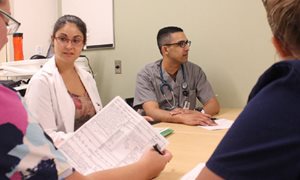 Over the past two years, Lawrence General has significantly improved patient flow throughout the hospital thanks to more than 20 performance improvement initiatives—both large and small—taking place across the organization. These efforts have led to incremental improvements in discharge times, shortened wait times for patients being admitted from the Emergency Center, and an enhanced patient experience. But there is still much work to be done as patients wait, on average, more than five hours for a bed, and can wait as long as two days.
Over the past two years, Lawrence General has significantly improved patient flow throughout the hospital thanks to more than 20 performance improvement initiatives—both large and small—taking place across the organization. These efforts have led to incremental improvements in discharge times, shortened wait times for patients being admitted from the Emergency Center, and an enhanced patient experience. But there is still much work to be done as patients wait, on average, more than five hours for a bed, and can wait as long as two days.
The hospital’s Annual Operating Plan is intended to bring even greater focus to improving the quality and efficiency of care delivery. This, in turn, means making substantial changes in how care is delivered across the organization.
As part of these efforts, the Patient Flow Steering Committee, chaired by Karen Moore, RN, senior vice president of Operations and Chief Nursing Officer, and comprised of senior clinical staff from across the organization, launched the Pathways to Patient Progression initiative earlier this year to improve the effectiveness of multidisciplinary rounding. A project team is being led by Teresa Pazdral, MD, vice chief of the Emergency Center, and Mike Guertin, director of Patient Care Services Business Operations.
“The goal of multidisciplinary rounds is for the care team to have a brief conversation about each patient and hit on three main questions: What are we doing for the patient medically, are there any barriers to a safe discharge we can impact now, and what is the estimated date of discharge,” says Dr. Pazdral.
This estimated date of discharge can be challenging to nail down, she adds, but is crucial to the planning process and keeping patients on track for a safe and efficient discharge. To get a better handle on determining the day of discharge for each patient, a database of target lengths of stay for the most common diagnoses has been established utilizing Lawrence General historical lengths of stay and the Medicare averages from across the nation. These target lengths of stay will be introduced to the daily huddle discussions at the end of August.
The Pathways to Progression team is also implementing a new standardized format for the multidisciplinary rounds called Status Now Action Planning (SNAP), which will go live on October 1. Workgroups are meeting regularly to refine the new processes.
“I feel like these changes to our multidisciplinary rounds will be transformative,” says Dr. Pazdral. “By building on all of the great systems already in place and making them even more efficient, we’ll ultimately free up beds and be able to do a better job for our patients.”